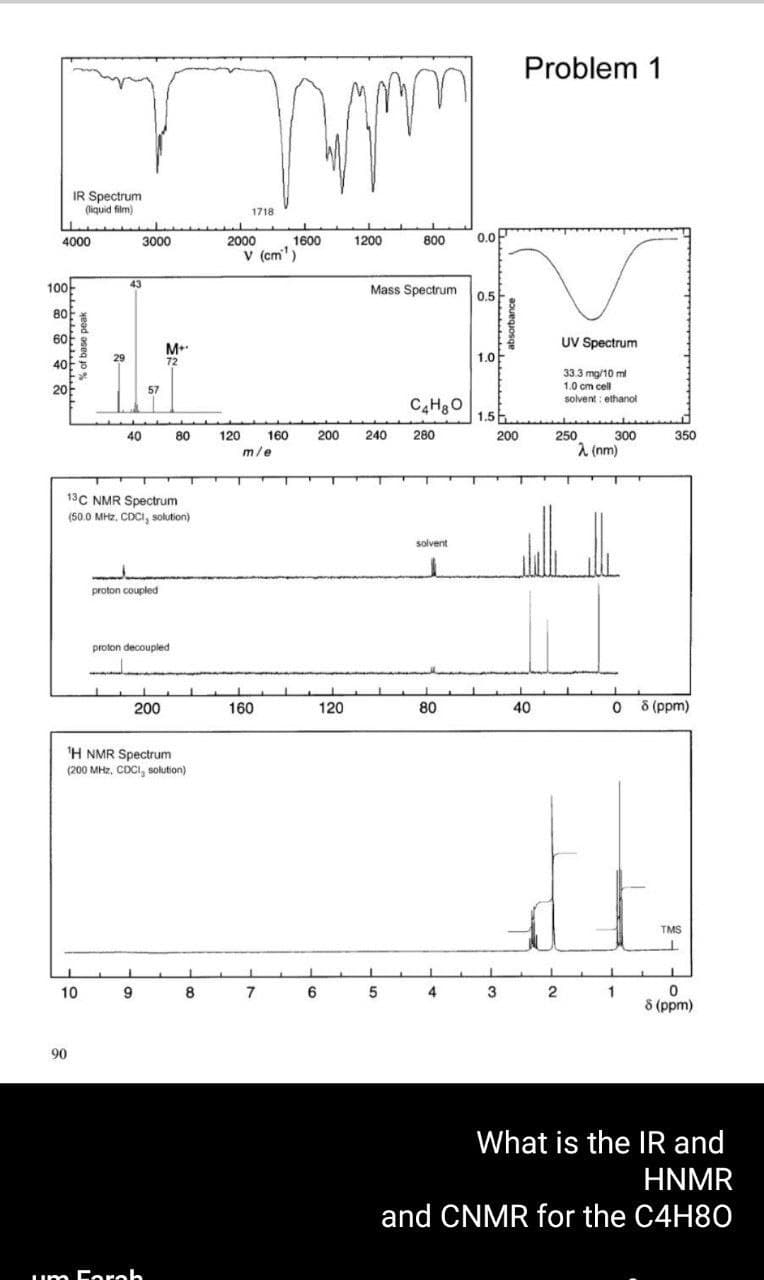Problem 1 IR Spectrum (liquid film) 1718 0.0P 1600 2000 V (cm") 4000 3000 1200 800 100- 43 Mass Spectrum 0.5 80 60F M+ UV Spectrum 1.0 40 33.3 mg/10 ml 1.0 cm cell solvent : ethanol CH3O 1.5. 200 240 280 300 250 2 (nm) 40 80 120 160 200 350 m/e 13C NMR Spectrum (50.0 MHz, CDCI, solution) solvent proton coupled prolon decoupled 200 160 120 80 40 O 8 (ppm) 'H NMR Spectrum (200 MHz, CDCI, solution) TMS 6 4 3 2 1 8 (ppm) 10 8 % of base peak absorbance
Problem 1 IR Spectrum (liquid film) 1718 0.0P 1600 2000 V (cm") 4000 3000 1200 800 100- 43 Mass Spectrum 0.5 80 60F M+ UV Spectrum 1.0 40 33.3 mg/10 ml 1.0 cm cell solvent : ethanol CH3O 1.5. 200 240 280 300 250 2 (nm) 40 80 120 160 200 350 m/e 13C NMR Spectrum (50.0 MHz, CDCI, solution) solvent proton coupled prolon decoupled 200 160 120 80 40 O 8 (ppm) 'H NMR Spectrum (200 MHz, CDCI, solution) TMS 6 4 3 2 1 8 (ppm) 10 8 % of base peak absorbance
Chemistry
10th Edition
ISBN:9781305957404
Author:Steven S. Zumdahl, Susan A. Zumdahl, Donald J. DeCoste
Publisher:Steven S. Zumdahl, Susan A. Zumdahl, Donald J. DeCoste
Chapter1: Chemical Foundations
Section: Chapter Questions
Problem 1RQ: Define and explain the differences between the following terms. a. law and theory b. theory and...
Related questions
Question

Transcribed Image Text:Problem 1
IR Spectrum
(liquid film)
1718
0.0P
2000
v (cm')
4000
3000
1600
1200
800
100-
Mass Spectrum 0.5
43
80
60
UV Spectrum
M*
72
1.0
33.3 mg/10 ml
1.0 cm cell
solvent : ethanol
20
57
1.5
40
80
120
160
200
240
280
200
250
300
2 (nm)
350
m/e
13C NMR Spectrum
(50.0 MHz, CDCI, solution)
solvent
proton coupled
proton decoupled
200
160
120
80
40
O 8 (ppm)
'H NMR Spectrum
(200 MHz, CDCI, solution)
TMS
10
9
8
7
6
5
4
3
1
8 (ppm)
90
What is the IR and
HNMR
and CNMR for the C4H80
um Foroh
% of base peak
absorbance
Expert Solution
This question has been solved!
Explore an expertly crafted, step-by-step solution for a thorough understanding of key concepts.
Step by step
Solved in 2 steps with 1 images

Knowledge Booster
Learn more about
Need a deep-dive on the concept behind this application? Look no further. Learn more about this topic, chemistry and related others by exploring similar questions and additional content below.Recommended textbooks for you

Chemistry
Chemistry
ISBN:
9781305957404
Author:
Steven S. Zumdahl, Susan A. Zumdahl, Donald J. DeCoste
Publisher:
Cengage Learning

Chemistry
Chemistry
ISBN:
9781259911156
Author:
Raymond Chang Dr., Jason Overby Professor
Publisher:
McGraw-Hill Education

Principles of Instrumental Analysis
Chemistry
ISBN:
9781305577213
Author:
Douglas A. Skoog, F. James Holler, Stanley R. Crouch
Publisher:
Cengage Learning

Chemistry
Chemistry
ISBN:
9781305957404
Author:
Steven S. Zumdahl, Susan A. Zumdahl, Donald J. DeCoste
Publisher:
Cengage Learning

Chemistry
Chemistry
ISBN:
9781259911156
Author:
Raymond Chang Dr., Jason Overby Professor
Publisher:
McGraw-Hill Education

Principles of Instrumental Analysis
Chemistry
ISBN:
9781305577213
Author:
Douglas A. Skoog, F. James Holler, Stanley R. Crouch
Publisher:
Cengage Learning

Organic Chemistry
Chemistry
ISBN:
9780078021558
Author:
Janice Gorzynski Smith Dr.
Publisher:
McGraw-Hill Education

Chemistry: Principles and Reactions
Chemistry
ISBN:
9781305079373
Author:
William L. Masterton, Cecile N. Hurley
Publisher:
Cengage Learning

Elementary Principles of Chemical Processes, Bind…
Chemistry
ISBN:
9781118431221
Author:
Richard M. Felder, Ronald W. Rousseau, Lisa G. Bullard
Publisher:
WILEY